This post contains affiliate links. If you click through and make a purchase, we may earn a commission at no additional cost to you. Thank you for your support
Thank you for reading this post, don't forget to subscribe!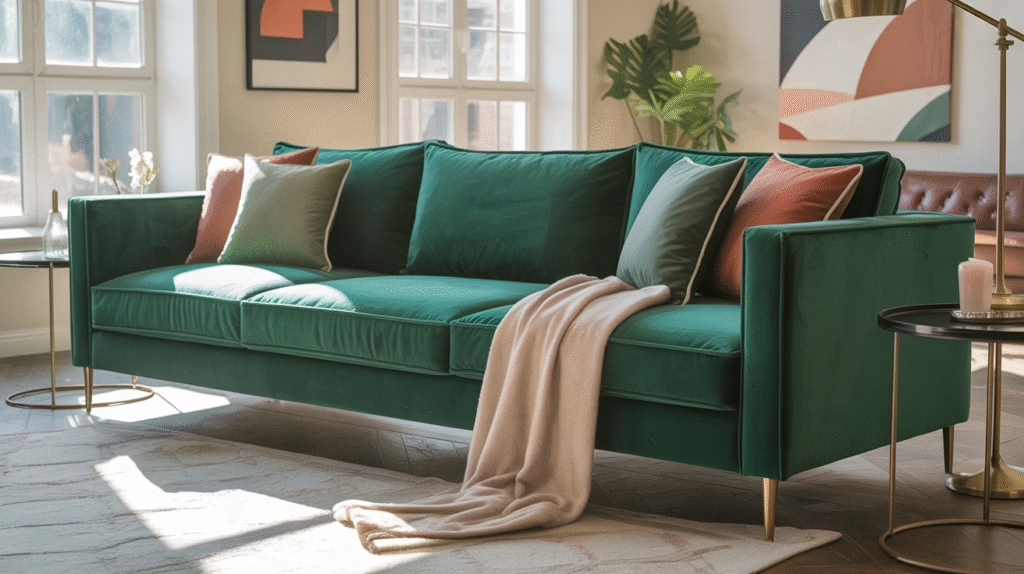
Creating a luxurious home doesn’t require a trust fund or unlimited credit. The democratization of design has made high-quality, stylish furniture accessible to everyone, regardless of budget. With strategic shopping and an eye for value, you can furnish your home with statement pieces that look expensive while keeping your finances firmly in check.
This comprehensive guide explores how to achieve luxury aesthetics on a budget, focusing on furniture pieces that deliver maximum visual impact without maximum price tags. We’ll examine what makes furniture look expensive, where to find quality pieces at affordable prices, and how to style budget-friendly furniture to create cohesive, sophisticated spaces.
Understanding Luxury Aesthetics
Before shopping for affordable luxury furniture, it’s important to understand what creates the perception of luxury in home furnishings. Luxury isn’t solely about price—it’s about quality materials, thoughtful design, and attention to detail.
Elements That Create Luxury Perception:
Material Quality: Even affordable furniture can feature quality materials. Look for solid wood frames, genuine leather accents, and durable upholstery fabrics. These materials age gracefully and maintain appearance over time.
Design Sophistication: Clean lines, balanced proportions, and thoughtful details elevate furniture from basic to beautiful. Classic designs with modern updates often appear more expensive than trendy pieces.
Craftsmanship Indicators: Well-constructed furniture features smooth finishes, aligned patterns, sturdy joints, and quality hardware. These details signal quality regardless of price point.
Color and Finish: Rich, saturated colors and quality finishes create luxury impressions. Deep jewel tones, sophisticated neutrals, and metallic accents all contribute to upscale aesthetics.
The Art of Budget Luxury Shopping
Finding affordable statement furniture requires strategy and patience. Understanding where and how to shop maximizes your budget while ensuring quality purchases.
Online Marketplace Advantages:
Online retailers offer significant advantages for budget-conscious shoppers. Lower overhead costs translate to lower prices. Extensive selections provide more options for finding perfect pieces. Customer reviews offer insights into quality and durability. Easy price comparisons ensure you’re getting the best deals.
Timing Your Purchases:
Furniture retailers follow predictable sales cycles. Major holidays (Memorial Day, Labor Day, Black Friday) bring significant discounts. End-of-season sales clear inventory for new collections. Floor model sales offer substantial savings on display pieces. Signing up for retailer newsletters provides early access to sales and exclusive discounts.
Quality Assessment from Photos:
When shopping online, carefully examine product photos and descriptions:
- Look for detailed construction information
- Check weight specifications (heavier often indicates better quality)
- Read dimensions carefully to ensure proper fit
- Examine close-up photos for finish quality
- Review customer photos for real-world appearance
Statement Furniture Categories
Accent Chairs: Instant Elegance
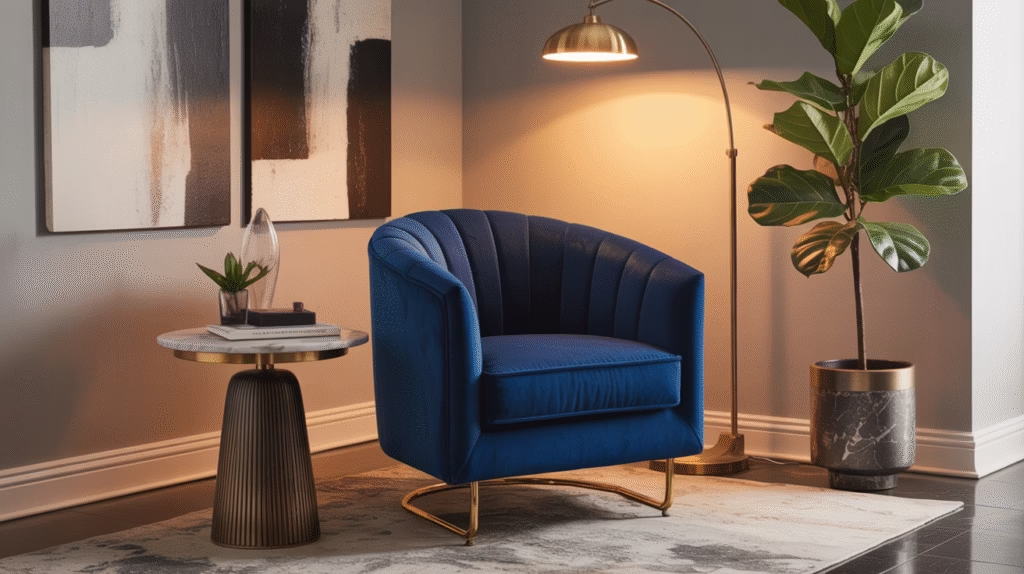
Accent chairs serve as jewelry for rooms—they add personality, color, and sophistication while providing functional seating. A well-chosen accent chair can anchor an entire room’s design.
Velvet Accent Chairs:
Velvet has experienced a major resurgence in interior design, and for good reason. This luxurious fabric catches light beautifully, creating depth and visual interest. Modern velvet upholstery is more durable and stain-resistant than historical versions, making it practical for everyday use.
Color Selection Strategy:
- Jewel Tones: Emerald green, sapphire blue, and ruby red create dramatic focal points
- Blush and Mauve: Softer tones add elegance without overwhelming
- Navy and Charcoal: Sophisticated neutrals that work with various color schemes
- Mustard and Cognac: Warm tones that add richness and depth
Frame and Leg Finishes:
Gold, brass, and rose gold legs elevate affordable chairs to luxury status. These metallic finishes catch light and add glamorous touches. Matte black legs create modern sophistication. Natural wood legs in walnut or oak tones provide timeless appeal.
Styling Accent Chairs:
Place accent chairs strategically to create conversation areas or reading nooks. Pair with complementary side tables and floor lamps. Add throw pillows in coordinating colors for extra comfort and style. Position near windows to showcase fabric texture in natural light.
What to Look For:
- Sturdy frame construction (hardwood or quality engineered wood)
- Dense foam cushioning that maintains shape
- Smooth, even upholstery without puckering
- Secure leg attachments
- Appropriate seat height (typically 18-20 inches)
Coffee Tables: Centerpiece Statements
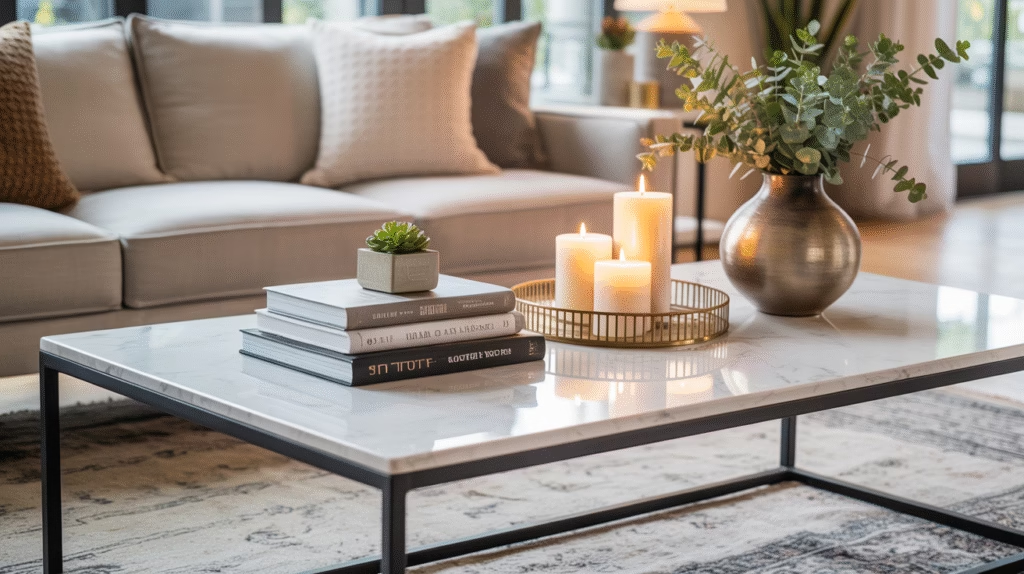
Coffee tables anchor living spaces and set the tone for entire rooms. The right coffee table balances functionality with aesthetic appeal, providing surface space while contributing to overall design.
Mid-Century Modern Designs:
Mid-century modern furniture remains popular because its clean lines and organic shapes work with various design styles. These timeless pieces blend seamlessly with both contemporary and traditional decor.
Material Combinations:
Wood and Metal: Warm wood tones paired with sleek metal frames create interesting contrasts. Look for solid wood tops rather than veneers for better quality and longevity.
Glass and Metal: Glass tops create airiness in small spaces while metal bases provide structural interest. Tempered glass ensures safety and durability.
Faux Marble: Modern manufacturing creates convincing marble alternatives at fraction of natural stone costs. These surfaces resist staining and require less maintenance than genuine marble.
Shape Considerations:
- Rectangular: Traditional choice that works in most spaces
- Round: Softens angular rooms and improves traffic flow
- Oval: Combines benefits of rectangular and round shapes
- Nesting Tables: Provide flexibility and can be separated when needed
Functional Features:
Look for coffee tables with storage options—drawers, shelves, or lift-tops. These features maximize functionality without sacrificing style. Ensure adequate clearance around the table (typically 18 inches) for comfortable movement.
Styling Your Coffee Table:
Create vignettes using books, decorative objects, and natural elements. Follow the rule of thirds—divide the surface into three sections and style each differently. Vary heights and textures for visual interest. Leave some negative space to avoid cluttered appearance.
Dining Furniture: Sophisticated Gathering Spaces
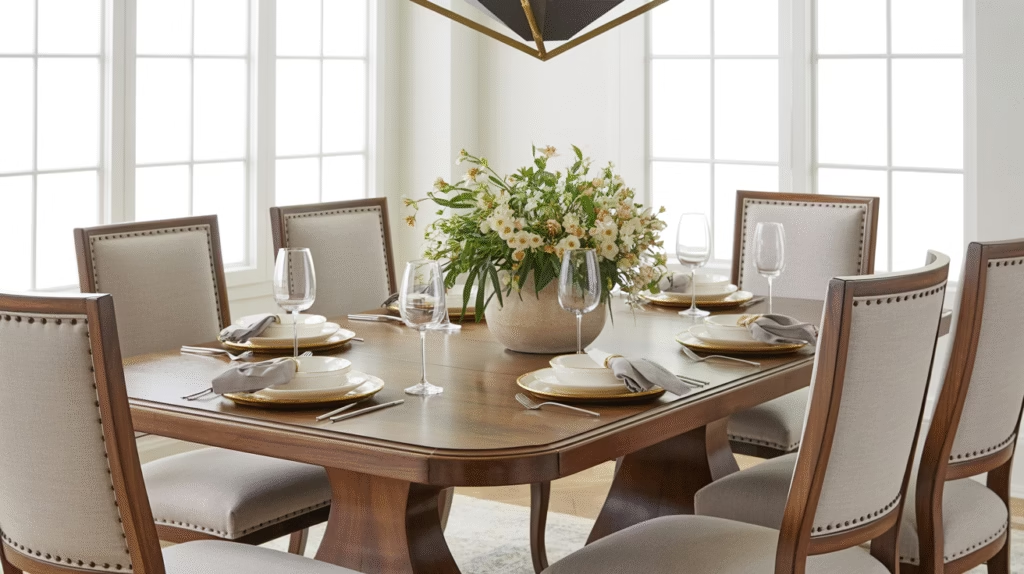
Dining areas serve as gathering places for meals, conversations, and celebrations. Investing in quality dining furniture creates welcoming spaces that encourage connection.
Dining Table Selection:
Size Considerations: Ensure adequate space around the table—36 inches minimum for comfortable chair movement. Measure your space carefully before purchasing. Consider extendable options for flexibility.
Material Choices:
Solid Wood: Durable and timeless, wood tables develop character over time. Look for hardwoods like oak, maple, or walnut for best quality.
Wood Veneer: Quality veneers over solid wood cores offer beauty at lower prices. Avoid particle board cores that won’t withstand daily use.
Glass: Creates modern elegance and makes spaces feel larger. Tempered glass ensures safety. Consider maintenance requirements—glass shows fingerprints and requires regular cleaning.
Faux Marble: Provides luxury look without weight and cost of genuine marble. Modern versions resist staining and scratching.
Dining Chair Considerations:
Mix and match chairs for eclectic, designer looks. Combine different styles while maintaining common elements—similar colors, complementary materials, or consistent heights.
Upholstered Chairs: Add comfort and softness to dining spaces. Choose performance fabrics for easy maintenance. Consider removable, washable covers for practical luxury.
Metal Chairs: Industrial-style metal chairs create modern edge. Look for powder-coated finishes that resist chipping and rust.
Wood Chairs: Classic and versatile, wood chairs work with various table styles. Ensure comfortable seat heights and back support.
Creating Cohesive Dining Spaces:
Coordinate dining furniture with lighting fixtures—chandeliers or pendant lights centered over tables create focal points. Add area rugs to define dining zones and absorb sound. Ensure rugs extend beyond chair perimeters when pulled out. Style tables with centerpieces that don’t obstruct sight lines during meals.
Storage Solutions: Beautiful Organization
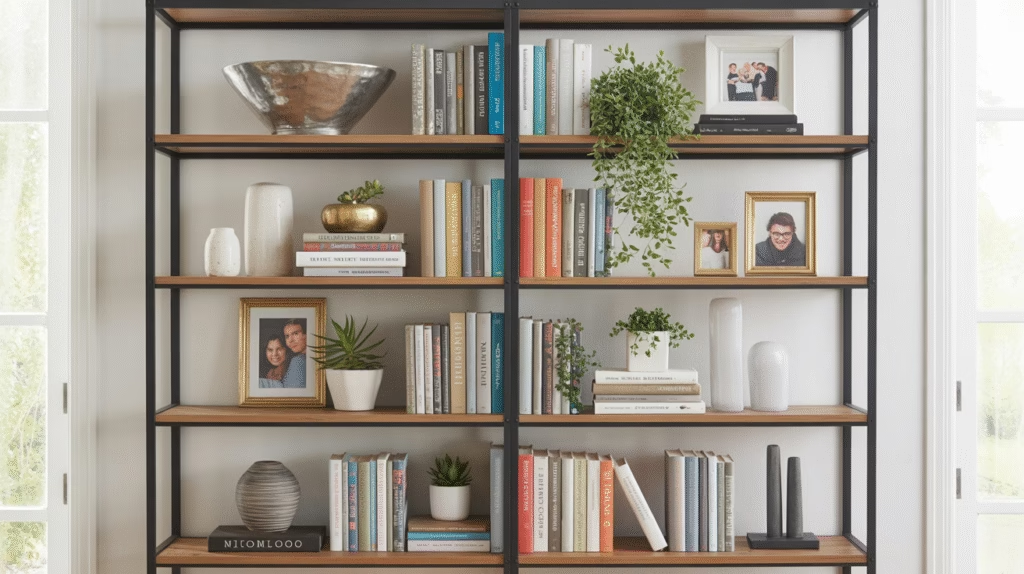
Storage furniture serves dual purposes—organizing belongings while contributing to room aesthetics. Well-designed storage pieces eliminate clutter while adding style.
Sideboards and Credenzas:
These versatile pieces work in dining rooms, living rooms, and entryways. They provide substantial storage while offering surface space for displays.
Style Options:
Mid-Century Modern: Clean lines, tapered legs, and warm wood tones create timeless appeal.
Industrial: Metal frames with wood or metal doors add urban edge.
Traditional: Ornate details and rich finishes create classic elegance.
Contemporary: Sleek designs with minimal hardware offer modern sophistication.
Functional Considerations:
Assess storage needs before purchasing. Adjustable shelves accommodate various item sizes. Drawers with smooth glides improve functionality. Cable management features help conceal electronics and cords.
Styling Sideboards:
Create balanced displays on top surfaces. Use the rule of three—group items in threes for visual appeal. Combine functional items (lamps, trays) with decorative objects (vases, artwork, books). Vary heights and textures. Consider adding mirrors or artwork above sideboards to create cohesive vignettes.
Bookcases and Shelving Units:
Open shelving displays collections while providing storage. Choose units with adjustable shelves for flexibility.
Styling Strategies:
Mix books with decorative objects. Arrange books both vertically and horizontally. Use bookends to create sections. Incorporate plants for natural elements. Display collections (ceramics, artwork, travel souvenirs) alongside books. Leave some empty space—overcrowded shelves appear cluttered.
Storage Ottomans:
These multifunctional pieces provide seating, footrests, and hidden storage. They work beautifully in living rooms, bedrooms, and entryways.
Selection Criteria:
Choose sizes appropriate for your space and needs. Consider upholstery durability—performance fabrics withstand heavy use. Ensure lids open easily and stay open safely. Look for adequate storage depth for intended items.
Bedroom Furniture: Restful Luxury
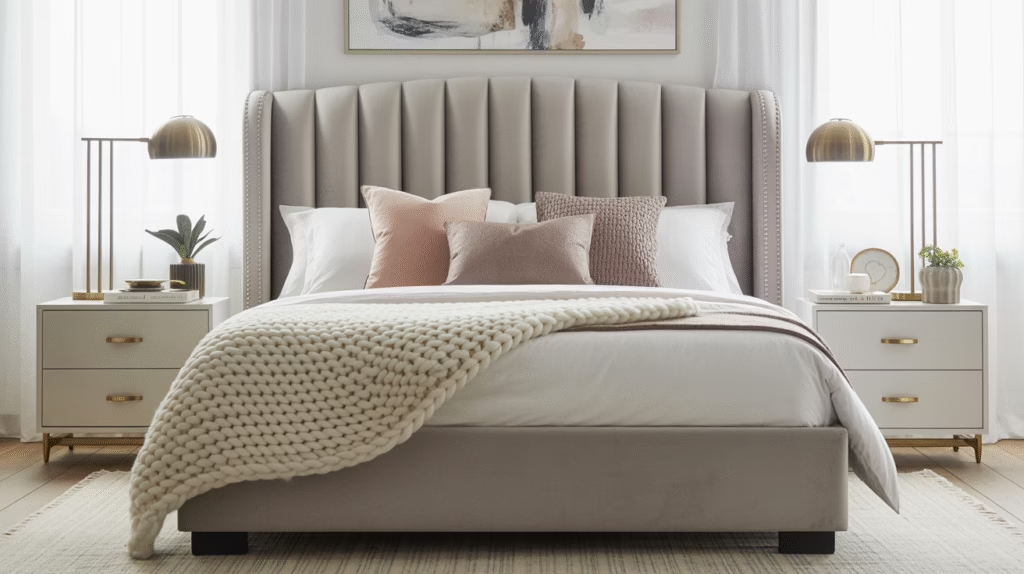
Bedrooms should feel like personal retreats. Quality bedroom furniture creates peaceful, organized spaces that promote rest and relaxation.
Upholstered Beds:
Upholstered beds add softness and luxury to bedrooms. Padded headboards provide comfortable support for reading or watching television.
Fabric Choices:
Velvet: Creates rich, luxurious appearance. Modern velvet resists crushing and maintains appearance.
Linen: Natural texture adds casual elegance. Linen breathes well and softens with use.
Performance Fabrics: Stain-resistant options provide practical luxury, especially important for households with children or pets.
Headboard Styles:
Tufted: Button tufting creates classic, sophisticated look. Deep tufting adds dimensional interest.
Wingback: Dramatic silhouettes make bold statements. Provide sense of enclosure and coziness.
Panel: Clean, simple designs work with various decor styles. Less ornate options suit modern aesthetics.
Bed Frame Considerations:
Ensure sturdy construction—solid wood or metal frames provide best support. Check slat spacing if using without box spring—closer spacing (3 inches or less) prevents mattress sagging. Consider storage options—beds with built-in drawers maximize space in smaller bedrooms.
Nightstands:
Nightstands provide essential bedside storage and surface space. Choose heights that align with mattress top for easy access.
Style Coordination:
Nightstands don’t need to match beds exactly. Complementary styles create collected, sophisticated looks. Ensure adequate surface space for lamps, books, and personal items. Look for drawers or shelves for hidden storage.
Dressers and Chests:
Quality storage furniture keeps bedrooms organized and clutter-free.
Construction Quality Indicators:
- Dovetail drawer joints (strongest construction)
- Smooth drawer glides (full-extension glides provide best access)
- Solid wood or quality veneer construction
- Secure hardware and knobs
- Level, stable construction
Styling Bedroom Furniture:
Create cohesive looks by coordinating finishes and styles. Mix wood tones for interest—don’t feel obligated to match everything exactly. Add personality through hardware—updating knobs and pulls customizes affordable pieces. Layer textiles (bedding, throws, pillows) to add luxury and comfort.
Area Rugs: Foundation for Luxury
Area rugs ground furniture arrangements, define spaces, and add warmth and texture. Quality rugs elevate entire rooms while providing practical benefits.
Rug Size Guidelines:
Living Rooms: Rugs should be large enough that all furniture legs rest on them, or at minimum, front legs of seating pieces. This creates cohesive, intentional arrangements.
Dining Rooms: Rugs should extend at least 24 inches beyond table edges on all sides, allowing chairs to remain on rugs when pulled out.
Bedrooms: Rugs should extend beyond bed sides and foot by at least 18-24 inches, creating soft landing spots when getting out of bed.
Material Considerations:
Wool: Durable, naturally stain-resistant, and luxurious. Wool rugs last decades with proper care.
Synthetic Fibers: Polypropylene and polyester offer affordability and easy maintenance. Modern synthetics mimic natural fiber appearance.
Natural Fibers: Jute, sisal, and seagrass create casual, textured looks. Best suited for low-traffic areas.
Pattern and Color Selection:
Traditional Patterns: Persian and Oriental designs create timeless elegance. Work with various furniture styles.
Geometric Patterns: Modern designs add contemporary edge. Bold patterns make statements in neutral rooms.
Solid Colors: Versatile foundations that showcase furniture. Darker colors hide stains better than light shades.
Rug Layering:
Create designer looks by layering rugs. Place smaller patterned rugs over larger neutral bases. This technique adds depth and visual interest while allowing flexibility in design updates.
Lighting: Illuminating Luxury
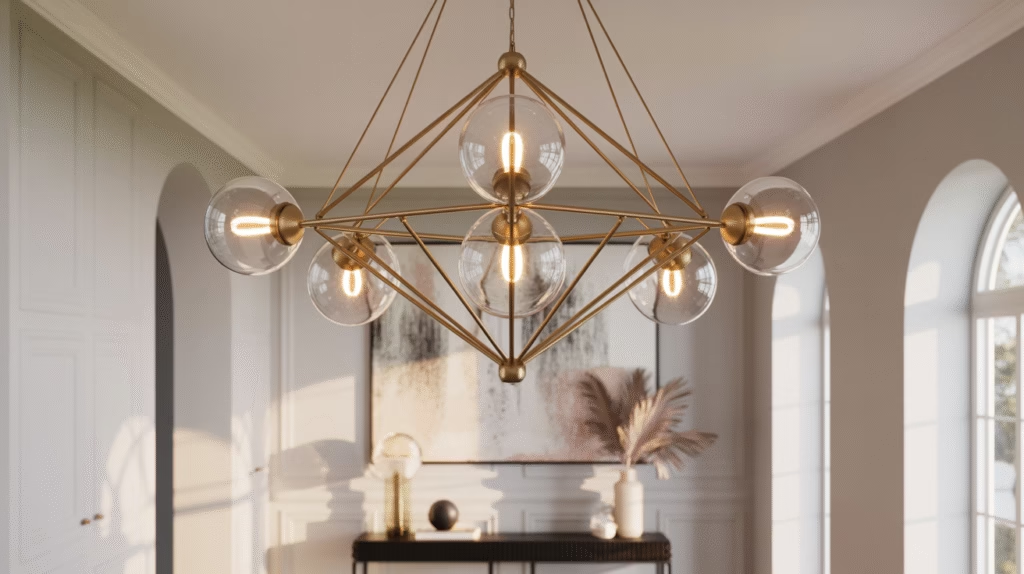
Lighting dramatically impacts room ambiance and perceived luxury. Statement lighting fixtures serve as functional art while providing necessary illumination.
Chandelier Selection:
Chandeliers create focal points and add elegance to dining rooms, entryways, and bedrooms.
Size Calculations:
Add room length and width in feet; convert to inches for appropriate chandelier diameter. For example, 12-foot by 14-foot room = 26-inch diameter chandelier.
Hang chandeliers 30-36 inches above dining tables. In entryways, ensure at least 7 feet clearance from floor to bottom of fixture.
Style Options:
Crystal: Traditional elegance that reflects light beautifully. Modern crystal chandeliers feature updated silhouettes.
Modern Geometric: Clean lines and interesting shapes create contemporary statements.
Industrial: Metal frames and Edison bulbs add urban sophistication.
Drum Shades: Fabric-covered fixtures provide soft, diffused light with elegant simplicity.
Pendant Lights:
Pendant lights work beautifully over kitchen islands, in dining areas, or as bedside lighting.
Grouping Strategies:
Hang pendants in odd numbers (three or five) for visual balance. Maintain consistent spacing between fixtures. Ensure adequate clearance—typically 30-36 inches above counters or tables.
Floor Lamps:
Floor lamps provide task lighting while adding vertical interest and style.
Arc Floor Lamps: Dramatic curved designs reach over seating areas, providing overhead lighting without ceiling installation.
Tripod Lamps: Three-legged bases create sculptural interest. Work well in modern and mid-century spaces.
Traditional Floor Lamps: Classic designs with fabric shades provide ambient lighting and timeless style.
Lighting Layering:
Create sophisticated lighting schemes by combining ambient, task, and accent lighting. Use dimmers to adjust mood and functionality. Coordinate finishes across fixtures for cohesive looks.
Styling Affordable Furniture for Luxury Looks
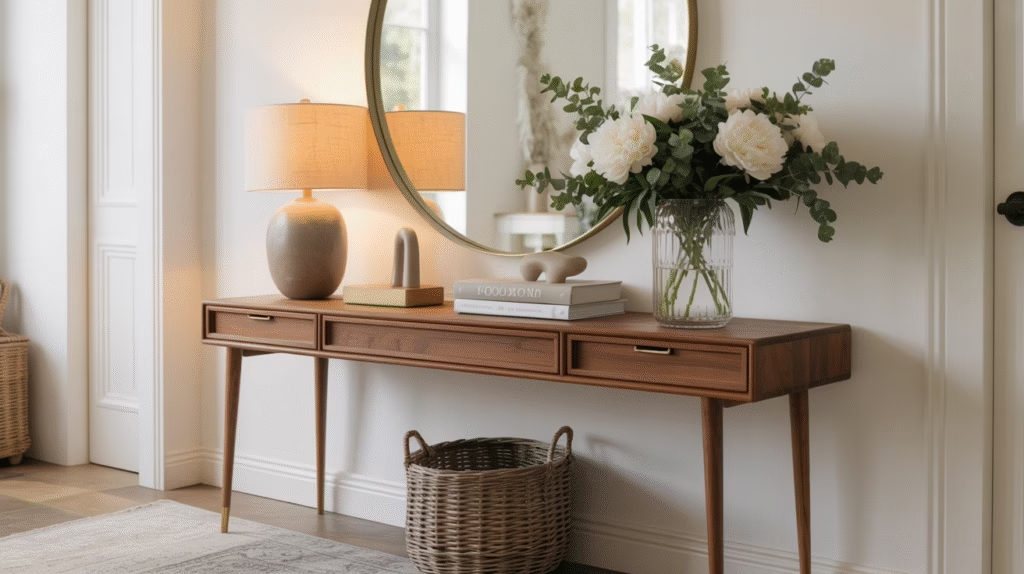
Even the most beautiful furniture requires thoughtful styling to achieve luxury aesthetics. These strategies elevate affordable pieces to designer status.
Color Coordination:
Create cohesive color schemes using the 60-30-10 rule: 60% dominant color, 30% secondary color, 10% accent color. This formula creates balanced, professional-looking spaces.
Texture Layering:
Combine various textures—smooth with rough, soft with hard, matte with shiny. Textural variety adds depth and interest, creating sophisticated, collected looks.
Scale and Proportion:
Ensure furniture fits spaces appropriately. Oversized furniture overwhelms small rooms; undersized pieces get lost in large spaces. Vary furniture heights to create visual interest.
Accessory Selection:
Quality accessories elevate affordable furniture. Invest in:
- Substantial throw pillows with quality inserts
- Luxurious throws in natural fibers
- Substantial artwork or mirrors
- Quality table lamps
- Decorative objects with meaning and beauty
Negative Space:
Resist the urge to fill every surface and corner. Negative space allows eyes to rest and prevents cluttered appearance. Curated, intentional arrangements appear more expensive than overcrowded spaces.
Maintenance and Care:
Keep furniture clean and well-maintained. Dust regularly, address spills immediately, and follow care instructions. Well-maintained affordable furniture looks better than neglected expensive pieces.
Common Mistakes to Avoid
Sacrificing Quality for Price:
Extremely cheap furniture rarely provides good value. It wears quickly, requiring replacement sooner than quality pieces. Invest in best quality your budget allows, focusing on pieces you’ll use most.
Ignoring Measurements:
Always measure spaces and doorways before purchasing. Furniture that doesn’t fit properly or can’t be delivered wastes money and creates frustration.
Following Trends Too Closely:
Trendy pieces date quickly. Choose classic designs with quality construction for longevity. Add trends through easily changed accessories.
Buying Complete Sets:
Matching furniture sets often appear generic and lack personality. Mix pieces for collected, sophisticated looks that reflect individual style.
Neglecting Comfort:
Beautiful furniture that’s uncomfortable won’t be used. Test seating comfort when possible. Read reviews about comfort levels for online purchases.
Building Your Luxury Home Over Time
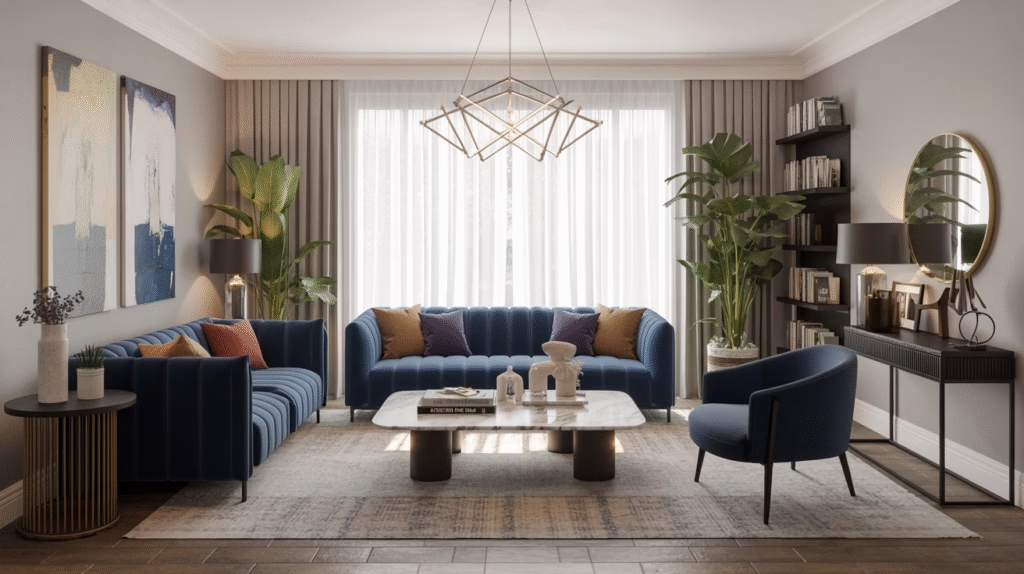
Creating a beautifully furnished home doesn’t happen overnight. Strategic, patient purchasing builds quality collections that last.
Prioritization Strategy:
Focus on pieces you’ll use most. Invest in quality sofas, beds, and dining tables before decorative items. Build collections gradually, choosing quality over quantity.
Investment Pieces:
Identify which pieces warrant higher investment. Sofas, mattresses, and dining tables receive heavy use and benefit from quality construction. Accent pieces can be more budget-friendly.
Seasonal Shopping:
Take advantage of sales cycles. Plan major purchases around holiday sales. Sign up for retailer newsletters to receive sale notifications and exclusive discounts.
Quality Assessment:
Learn to identify quality construction. Examine joints, finishes, and materials. Read reviews from verified purchasers. Don’t hesitate to ask questions about construction and materials.
Conclusion
Luxury living doesn’t require luxury budgets. With strategic shopping, quality assessment skills, and thoughtful styling, you can create sophisticated, beautiful spaces filled with statement furniture that looks far more expensive than its price tag suggests.
The key lies in understanding what creates luxury perception—quality materials, thoughtful design, and attention to detail. Focus on these elements rather than price tags, and you’ll build a home that reflects refined taste and personal style while respecting budget constraints.
Remember that creating your ideal home is a journey. Start with foundational pieces, build gradually, and enjoy the process of curating spaces that bring joy and comfort. Your dream home doesn’t require unlimited funds—it requires vision, patience, and the knowledge to recognize quality and value when you find it.
With these strategies and insights, you’re equipped to furnish your home with beautiful, affordable statement pieces that create the luxury aesthetic you desire. Happy shopping, and enjoy the process of creating your personal sanctuary.